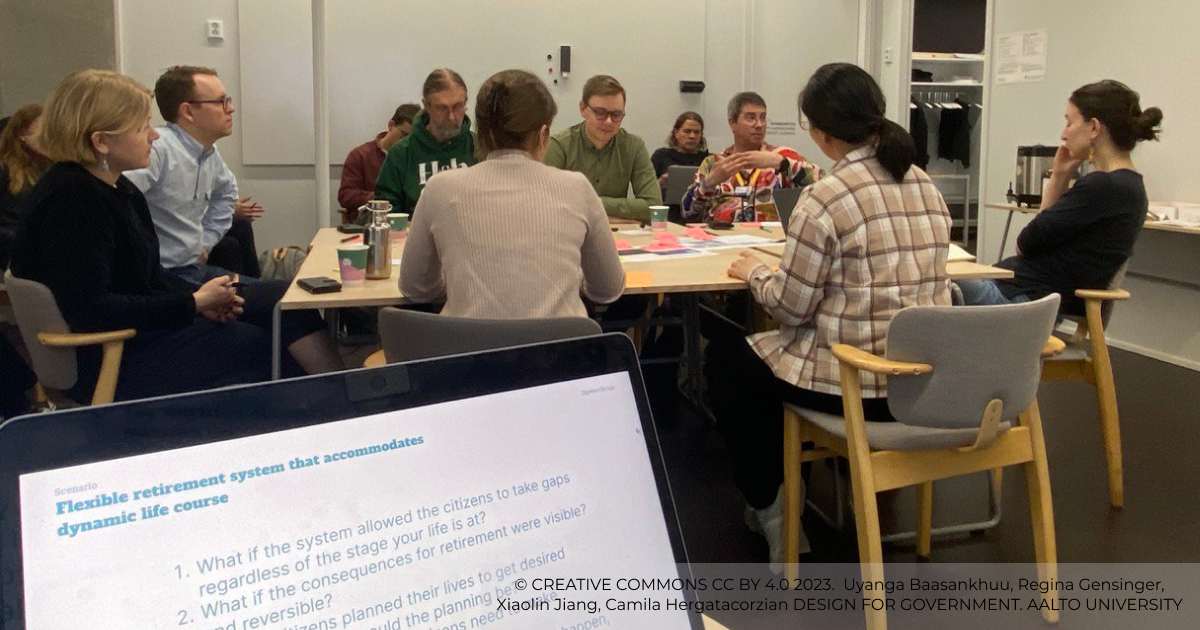This blog post reports on work-in-progress within the DfG course! The post is written by group 1B working in collaboration with the Digital Population and Data Services (DVV) and the Ministry of Finance (VM) on the project ‘Life events for a dignified old age’. The group includes Uyanga Baasankhuu from Collaborative and Industrial Design program, Xiaolin Jiang from Human Computer Interaction program, Regina Gensinger from Creative Sustainability program, and Camila Hergatacorzian from Collaborative and Industrial Design program.
Written by: Uyanga Baasankhuu
Just to give a little recap of what happened with our project before this post, I should talk about the problem framing we shared with the supergroup peers and partners first. During these weeks, we had condensed our understanding of the issues around ‘dignified old age’ from a megatrends perspective. Our insight on how the current system for retirement does not accommodate the dynamic life of modern citizens had garnered quite a bit of discussion and generated interesting ideas during the co-creative session with our partners. Now, our quest progresses forward to the first part of the solution space — Design Intervention.

Idea generation workshop with our partners from DVV (Digital and Population Data services agency)
Puzzle pieces come together to create a picture
As my team member, Xiaolin described in their blog before this post, mapping out the system did not happen to us naturally. To be honest, I felt stuck… and I am sure my fellow teammates shared the same feeling as we sat around discarding papers with arrows, circles, and diagrams one after another. Contrary to our inclinations toward creating a system map showing the entirety of every possible element and interconnectedness as one piece, megatrends insights we found did not fit in. It was time to change gears. We started from what we could visualize to convey what we mean for each insight thanks to Núria’s encouragement. Personally, I felt like we failed in systems thinking. Because the system is supposed to be a big and complex picture, right? But ours was fragmented. Only when we stepped back from obsessing over the big picture and returned to it armed with an intervention mindset and ideas generated by our partners from DVV (Digital and Population Data services agency), we realized that actually, what we previously considered as ‘fragmentations’ collectively revealed recurring patterns. That too, quite an interesting one if we overlap them together. You will get to know about it later in this blog.
The art of knowing what to tinker with
“The more efficient you are at doing the wrong thing, the wronger you become.”
– Russel Ackoff
As designers, we are trained to jump into concluding research findings and dive directly into providing concrete solutions. For us, questions we were asking ourselves through our insights pulled us in multiple directions. At the same time, tackling these issues within a given timeframe urged us to lock in one to progress forward. But we hesitated, as these questions still called us to find answers…
Are senior citizens being forced out of the workforce because of the introduction of technology in the workplace? Is digitalization to blame or ageism in society?
People’s lives are not as linear and homogeneous as they used to be. Is the retirement system ready to accommodate this change?
The public sector is to face a healthcare crisis due to an aging population and labor force shortage. Is technology the only solution for it?
Pondering a strategic intervention that affects the whole system through Meadows’ leverage points (1999), a new notion for us, required a bit of unlearning. As we learned, hopping onto issues one by one without seeing the “whole forest” is energy-consuming and expensive. Some of the solutions may create other problems we have never anticipated before. The interventions we think are right instinctively, can be counterintuitive as Forrester (1969) stated in their book. The biggest learning from this whole ‘leveraging’ phase we find ourselves in is finding a vantage point to see the underlying connections between the system issues, if there are any. But there are many, definitely.
Way forward from the vantage point
Back to the biggest reveal — Our intervention. If we overlap the system maps we drew, you could see the new element and connection we introduced in the ‘to be’ situation is literally the Meadows’ delay in feedback loops and introducing an element to decrease that gap.

Donella Meadows’ leverage points
As Komp-Leukkunen (2022) argues in their life courses approach to ageing, the population’s life experiences accumulate to shape their old age. What if we would intervene at the right time to avoid the multitude of issues we are facing as a society for rapid population aging? What if we decrease this gap between actions individuals or decision-makers make and the consequences of those? What if there is a model for closing the gap of life events that can be integrated into various aspects of our lives such as health, education, career, resources, and pension system policies altogether? As you may have guessed from these questions, we decided to embark on formulating a model to help our society to close the feedback gap between “dignified old age” of future and present circumstances. Stay tuned for how this journey unfolds.
References:
Akinola. S (2021) What is the biggest benefit technology will have on ageing and longevity? https://www.weforum.org/agenda/2021/03/what-is-the-biggest-benefit-technology-ageing-longevity-global-future-council-tech-for-good/
Forrester, J.J. (1969). Urban Dynamics.
Komp-Leukkunen, K (2021). Finnish life-courses: A phenomenon of central interest in times of population ageing
Komp-Leukkunen, K (2022). A Life-Course Perspective on Older Workers in Workplaces Undergoing Transformative Digitalization
Meadows, D (1999). Leverage Points: Places to Intervene in a System.
Tergesen, A (2022). What Old Age Might Be Like for Today’s 30-Year-Olds https://globalcoalitiononaging.com/2022/11/17/what-old-age-might-be-like-for-todays-30-year-olds/
The DfG course runs for 14 weeks each spring – the 2023 course has now started and runs from 27 Feb to 31 May. It’s an advanced studio course in which students work in multidisciplinary teams to address project briefs commissioned by governmental ministries in Finland. The course proceeds through the spring as a series of teaching modules in which various research and design methods are applied to address the project briefs. Blog posts are written by student groups, in which they share news, experiences and insights from within the course activities and their project development. More information here about the DfG 2023 project briefs.


What is the focus and objective of the work-in-progress project reported in the blog post, and how does Group 1B collaborate with Digital Population and Data Services (DVV) and the Ministry of Finance (VM) in this context? Can you provide details about the members of the group and their respective programs, as well as the specific project they are working on related to ‘Life events for a dignified old age’?